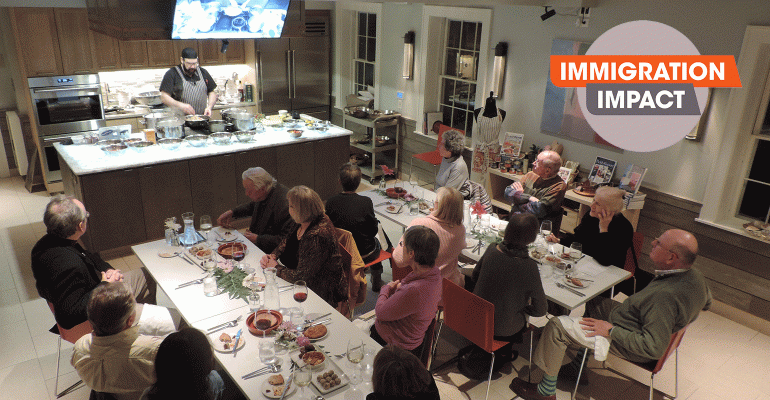 In this ongoing in-depth investigation, NRN looks at how the current political environment could affect immigration and what it means for restaurant operators.
In this ongoing in-depth investigation, NRN looks at how the current political environment could affect immigration and what it means for restaurant operators.
A chef’s inspirations, beliefs and viewpoints are often best expressed on the plate. As news of the travel ban affecting Iran, Iraq, Syria, Sudan, Somalia, Libya and Yemen hit, U.S. chefs took to the kitchen and let the flavors of these countries make a point.
Earlier this winter in Indianapolis, during a menu planning session at edgy new restaurant Marrow, chef John Adams and the staff were lamenting that fact that due to work schedules, they had missed protest events and marches they would’ve liked to attend.
“We had missed the Women’s March and some airport protests, so we wanted to make a difference in the way we could: through the restaurant,” Adams said.
 Pictured: Sudanese sorghum porridge
Pictured: Sudanese sorghum porridgeMarrow’s family-style cuisine is billed as “global soul food,” so this idea was a good fit. The kitchen team immediately set to work, firing up Google, heading to the library for cookbooks and getting familiar with dishes from the seven countries affected by the travel ban for a menu that would be in place for six weeks.
“We were looking for things that would work on our menu,” Adams said. “We got completely immersed in it.”
And so it went, with the team adapting dishes such as Somalian fried doughnuts with nigella seeds and date glaze as a table snack; seared foie gras with sorghum porridge from Sudan; Iraqi lamb sweetbreads; Iranian saffron rice pudding simmered with rose water and garnished with almond and pistachios; chicken mandi from Yemen that’s braised in butter and infused with the flavors of coriander, cumin, garlic and saffron and Libyan shakshuka.
Whether customers and investors would see this menu as an outright protest didn’t bother Adams one way or another.
“Business-wise, we saw a boost…maybe we pissed some people off, but I highly doubt it,” Adams said, considering. “And if we did, maybe that’s okay, too. We keep it real in the Midwest.”

In fact, the feedback was overwhelmingly positive.
“We had people come back to the kitchen and say, ‘Thank you from my family for doing this menu. It means a lot to us,’” Adams said, adding that the response on social media was big, and business increased during a historical slump after Valentine’s Day.
In addition, this opened up a new possibility at Marrow: changing menus based on one cuisine, a culinary deep dive into different cultures as a delicious educational experience. Next up, Marrow will be delving into aspects of French cuisine.
 Meanwhile in Nantucket, chef Greg Margolis of the Corner Table Cafe planned a cooking demonstration and dinner at the Nantucket Culinary Center to raise funds for the American Civil Liberties Union. The event, titled Our Loving Community: Food from 7 Banned Countries, featured dishes from each of those countries.
Meanwhile in Nantucket, chef Greg Margolis of the Corner Table Cafe planned a cooking demonstration and dinner at the Nantucket Culinary Center to raise funds for the American Civil Liberties Union. The event, titled Our Loving Community: Food from 7 Banned Countries, featured dishes from each of those countries.
“I just wanted to bring awareness to the diversity and similarities of these countries in comparison to our,” Margolis said. “As a human race, we all need to eat, and more often than not we are using the same ingredients and preparation methods as those in other nations.”
And there are more chefs wielding flavors as a form of protest. Chef Hari Pulapaka of the seasonal-food concept Cress Restaurant in DeLand, Fl., recently staged on a charity benefit “7 Courses-7 Countries” that benefitted the Bokeh Studio International Rescue organization. And New York Chef Sara Jenkins of Italian-food restaurant Porsena, inspired by a news story of a Syrian family affected by the travel ban, served an a la carte menu with dishes from Syria.
Contact Tara Fitzpatrick at [email protected]
Follow her on Twitter: @Tara_Fitzie


